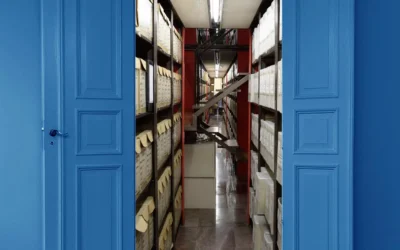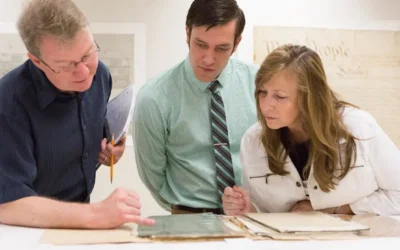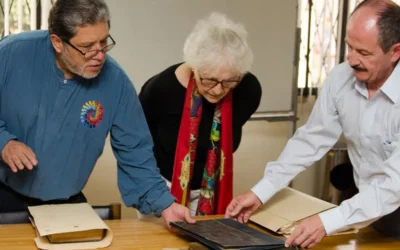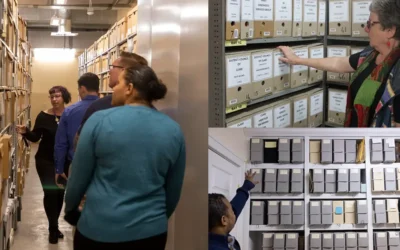Approaches to Acquisition
Margot Note
The selection of records of enduring value is the archivist’s first responsibility. All other archival activities hinge on the ability to select wisely. Archivists must educate themselves about the records of contemporary society and improve archival practice accordingly.
They should educate records creators about the importance of retaining records of long-term importance and inform the public about the essential work of the archival profession, so they will influence and support creators in the preservation of their records.
There are two basic approaches to acquisition: systems and solicitation. Using a systems approach, the archivist works with an ongoing organization to set up arrangements for regular transfer of files. Much of this is based on records management, where decisions are made about the type and source of files, and records retention schedules establish a routine for transfer. Institutional archives tend to use the systems approach.
A solicitation approach, on the other hand, is an acquisition of individual collections, resulting in negotiations for discrete bodies of material. This approach is usually used for collecting archives, repositories that collect materials from individuals, families, and organizations other than their parent organizations.
In soliciting materials, archivists meet and deal with donors, which requires skill and tact. The archivist must always be sensitive to the relationship between the donor and the materials. Archivists may be dealing with the person who generated the collection, a family member, representative of the organization, an executive, or a dealer.
Archives are acquired by both gift and purchase. Occasionally archivists borrow to copy a collection and then return the originals, which is done as a last resort. Possibilities for acquisition range from paying for a collection to requiring the donor to cover processing and preservation costs. The latter is more common with organizational records and ongoing acquisition. The financial aspects behind buying archival collections are purposely secretive, and collections of well-known creators fetch high prices.
A More Active Role
Historically, American archives evolved into repositories that documented the establishment, with a focus on traditional institutions and “great white men.” The tendency was also to collect what came through the door, rather than to develop an active solicitation program based on a well-conceived collecting policy. Archivists have been rightfully pushed into a more activist and active role by interrelated developments in recordkeeping.
A structural change in society has made the records of organizations and institutions more important than personal papers. Along with this is the increasing importance of government records at all levels. Another factor is bulk. The increase in the number of records has forced archivists to make tough decisions. There is also the issue of missing data: information that used to be recorded in easily preservable forms is now more ephemeral. Vulnerable records also exist. Many kinds of activity are temporal, and the people involved more focused on the work at hand rather than long term preservation of information. Finally, technology has revealed the fragility of digital media. Archivists must get involved in the process of digital preservation at an early stage.
Factors to Consider
There are several factors to consider when contemplating adding a collection to a repository’s holdings. First, consider the source. Are these the papers of an individual or the records of an organization? Organizational records are bulkier and more costly to process and store but often have more varied research potential.
What kinds of materials are in the collection? Archivists need to be conscious of what kind of groups generated what types of material, some of which require special conditions or equipment.
Think about the relationship of the acquisition to the defined scope of the repository. Is this collection consistent with the institutional collecting policy?
Ponder the potential size of the collection. How large is it? Is more space required? Large collections should not be turned down for smaller collections. One 200 cubic foot collection may be more historically valuable than 200 one-foot collections.
What is the physical condition of the collection? Where it was stored can alert archivists to potential problems. Will reformatting or conservation treatment be required?
What is the potential research value of the collection? Who might use this collection, and for what kinds of research?
A Broader Understanding
Archivists play an important role in shaping repository collections. They need to have a broader understanding of the documentary universe, and not just the purview of the individual institution. Archivists should consider all the different formats that document a topic or group in order to acquire primary sources of lasting historical and cultural value.
Margot Note
Margot Note, archivist, consultant, and author is a regular blogger for Lucidea, provider of ArchivEra, archival collections management software for today’s challenges and tomorrow’s opportunities. Read more of Margot’s posts here.
Never miss another post. Subscribe today!
Similar Posts
Unlocking Access in Archives
The shift in archival processing from a rigid structure to a more flexible, access-oriented approach is crucial in meeting the dynamic needs of users.
Enhancing Collaboration; Methods for Archivists
Archivists can enhance collaboration through user-centric approaches and efficient processing methods based on customer service principles.
Navigating Selection in Archival Practice
The archival selection process is far from straightforward, given the limitations of long-term preservation and ongoing accessibility challenges.
Responsible Stewardship in Archival Practice
Responsible stewardship is a philosophy that guides the actions and decisions of archivists in safeguarding collective memory.
Hosting service
Enjoy all of the benefits of your Lucidea solution with secure, reliable, stress free hosting
Programs & incentives
No matter your size or budget, we’ve got you covered, today and tomorrow




Leave a Comment
Comments are reviewed and must adhere to our comments policy.
0 Comments